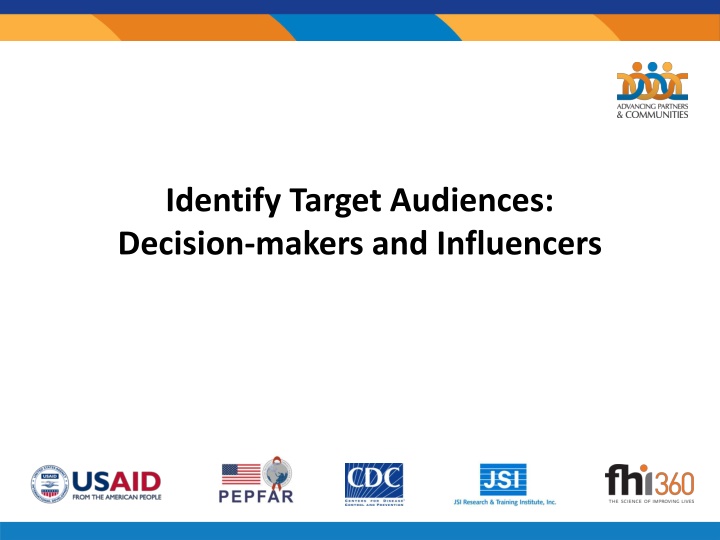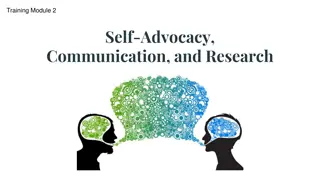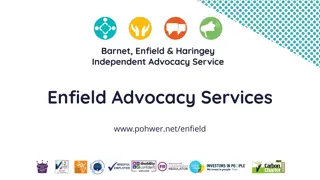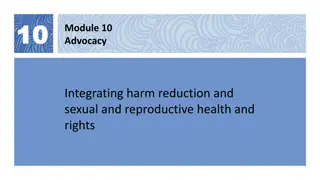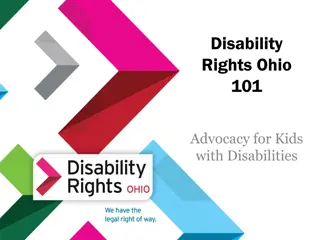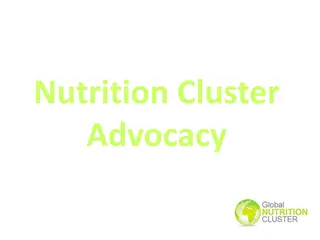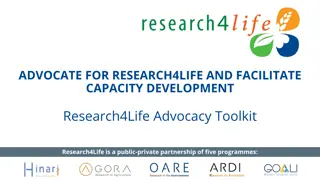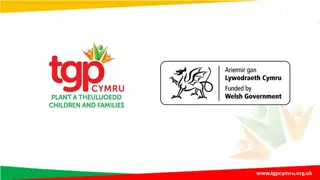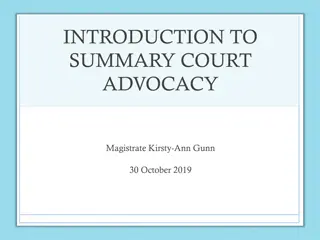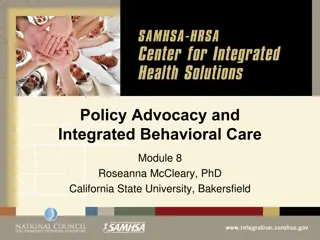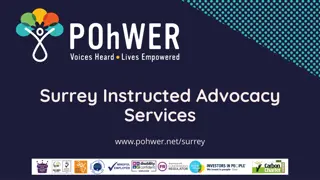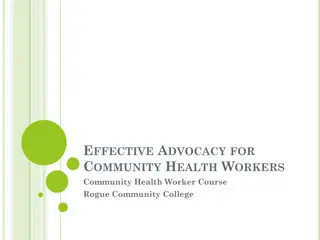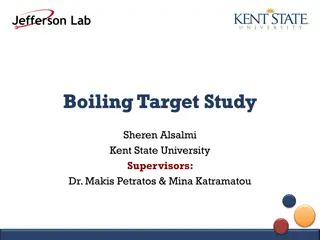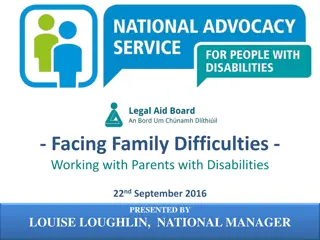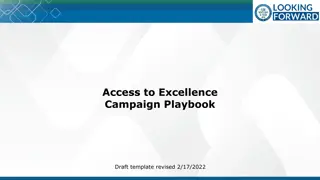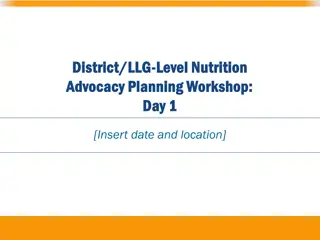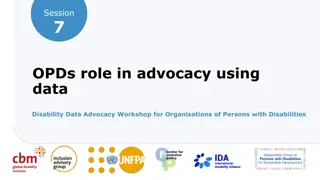Target Audiences and Stakeholders in Advocacy
Learn how to identify primary decision-makers, secondary influencers, and potential opposition in advocacy campaigns. Discover the importance of understanding power dynamics through mapping stakeholders' positions and relationships. Utilize this knowledge to create effective advocacy strategies in pursuit of policy change.
Download Presentation

Please find below an Image/Link to download the presentation.
The content on the website is provided AS IS for your information and personal use only. It may not be sold, licensed, or shared on other websites without obtaining consent from the author.If you encounter any issues during the download, it is possible that the publisher has removed the file from their server.
You are allowed to download the files provided on this website for personal or commercial use, subject to the condition that they are used lawfully. All files are the property of their respective owners.
The content on the website is provided AS IS for your information and personal use only. It may not be sold, licensed, or shared on other websites without obtaining consent from the author.
E N D
Presentation Transcript
Identify Target Audiences: Decision-makers and Influencers
Step 3: Identify Target Audiences Step 3: Identify Target Audiences- - Decision Influencers Influencers Decision-makers and Influencers Decision- -makers and makers and Step 3: Identify Target Audiences: Target audiences: whom we advocate to (primary and secondary) Primary: the decision-makers who have the authority to bring about the desired policy change Secondary: people who have access to and are able to influence the primary audience Know the policymaking process so that you can use it when deciding how to approach your target audiences. Know the audiences and their relationships with each other to create suitable advocacy strategies and messages.
Primary and Secondary Target Audiences Primary and Secondary Target Audiences Primary Decision-making power Often easy to identify Secondary Influential with the primary target audience May be a gatekeeper for other audiences Influential with other secondary target audiences Someone you have access to and credibility with
Opposition Opposition Opponents are those not in favor of the suggested policy change. May oppose due to: Lack of information Concerns about funding Desire to maintain status quo Timing Know the opposition and their motives, arguments, strengths, and level of influence with the target.
Power Map Power Map Visually depicts the target audiences and other stakeholders position related to an advocacy issue support, oppose, or neutral.
Power Map Example Power Map Example Advocacy Objective: The director of the HIV/AIDS Department of the Ministry of Health will form a task force to compile and review national health budget data by the end of 2013. Support Neutral Oppose Capital PLHIV Association Director, Health Budget Office Leader of care and treatment technical working group Cabinet secretary Director, HIV/AIDS Dept. President of National AIDS Control Coalition Indicates a relationship between two stakeholders Indicates an existing relationship with your organization AA Indicates amount of influence (the larger the font the greater the influence)
Activity Activity 1. Select one advocacy objective. 2. Develop a power map (30 minutes). Brainstorm stakeholders with some relationship to your advocacy objective; think of traditional and nontraditional targets, allies, and other groups with an interest in this issue (e.g., community leaders, celebrities, business leaders, relatives of the target audience). Part 1 Part 1 Write the names of the individual stakeholders; place them on the map according to their support/opposition/neutral (if unknown, choose neutral); size of name = power. Indicate relationships between organizations using arrows and other symbols.
Activity Activity Part 2 Part 2 3. On your power maps, draw a square around primary targets and an oval around secondary targets (30 minutes). 4. Prepare to present your power map (presentations 5 7 minutes per group). Activity adapted from: Networking for Policy Change: An Advocacy Training Manual, 1999.
Target Audience Analysis Target Audience Analysis Consider: 1. Level of knowledge about the advocacy issue 2. Level of support or opposition for the issue 3. Motivations of the target audience 4. How the target audience gathers and processes information
Target Audience Analysis Target Audience Analysis 1. Level of knowledge about the advocacy issue How much does the target audience know about the issue? Is the target audience well informed or do they lack accurate information?
Target Audience Analysis Target Audience Analysis 2. Level of support for or opposition to the issue Has the target audience actively and/or publicly supported or opposed this issue? What is the evidence/information available? If no evidence, what do we assume their position to be based on our contextual knowledge? Are you uncertain of their position?
Target Audience Analysis Target Audience Analysis 3. Motivations of the target audience How could your target audience benefit from supporting your advocacy goal/objective? What motivates the target audience to act? Examples: Celebrity gets enhanced image/reputation Politician gets good media coverage, aligns with re-election goals
Target Audience Analysis Target Audience Analysis 4. How the target audience gathers/processes information What information sources does the audience rely on? How does the audience best process information? Example: A PhD may prefer epidemiological statistics, whereas a politician may prefer polling data.
Activity Activity 1. Transfer the primary and secondary target audiences from your power map to the Audience Analysis Worksheets. 2. In your groups, complete a worksheet for each target audience, alternating between primary and secondary target audiences. Complete at least one primary and one secondary target analysis in the next 45 minutes.
Considerations for Analyzing the Information Considerations for Analyzing the Information Statements in support of or against your issue? Occasional or frequent statements = high rank No or infrequent statements = low rank Awareness of, or accuracy of, information? Accurate information shared = high rank Lack info or inaccurate info = low rank Benefits for the target audience? Audience interests aligned with issue Timing of events (e.g., elections, public holidays) Information gathering and processing? Data or story driven Details or big picture
Discussion Questions Discussion Questions What additional information do you need for an accurate assessment? Where will you get the information? Why do we identify potential benefits to target audiences? What should we do with a target audience who is strongly opposed to our issue?
Learning Objectives Learning Objectives Session 7 Session 7 Define primary and secondary target audiences Describe the key elements of a power map Use a power map to illustrate stakeholders and their positions related to a policy advocacy objective List four key areas to consider when conducting a target analysis Apply target analysis techniques to specific target audiences
